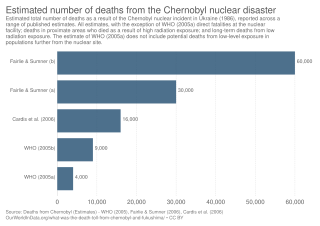 W
WThe 1986 Chernobyl disaster triggered the release of substantial amounts of radioactive contamination into the atmosphere in the form of both particulate and gaseous radioisotopes. As of 2020 it is the most significant unintentional release of radioactivity into the environment.
 W
WThe following table compares the nuclear accidents at the Chernobyl (1986) and Fukushima Daiichi (2011) nuclear power plants, the only INES level 7 nuclear accidents to date.
 W
WChernobyl Children International (CCI) is a non-profit, international development, medical, and humanitarian organisation that works with children, families and communities that continue to be affected by the economic outcome of the 1986 Chernobyl accident. The organisation's founder and chief executive is Adi Roche. Before 2010, it was known as Chernobyl Children's Project International (CCPI).
 W
WThe Chernobyl Nuclear Power Plant Zone of Alienation is an officially designated exclusion zone around the site of the Chernobyl nuclear reactor disaster. It is also commonly known as the Chernobyl Exclusion Zone, the 30 Kilometre Zone, or simply The Zone.
 W
WThe Polesie State Radioecological Reserve is a radioecological nature reserve in the Polesie region of Belarus, which was created to enclose the territory of Belarus most affected by radioactive fallout from the Chernobyl disaster. The reserve adjoins the Chernobyl Exclusion Zone in Ukraine. The environmental monitoring and countermeasure agency, Bellesrad, oversees the food cultivation and forestry in the area.
 W
WThe Chernobyl Nuclear Power Plant Zone of Alienation is an officially designated exclusion zone around the site of the Chernobyl nuclear reactor disaster. It is also commonly known as the Chernobyl Exclusion Zone, the 30 Kilometre Zone, or simply The Zone.
 W
WThe Ukrainian National Chernobyl Museum is a history museum in Kyiv, Ukraine, dedicated to the 1986 Chernobyl disaster and its consequences. It houses an extensive collection of visual media, artifacts, scale models, and other representational items designed to educate the public about many aspects of the disaster. Several exhibits depict the technical progression of the accident, and there are also many areas dedicated to the loss of life and cultural ramifications of the disaster.
 W
WChernobyl Way is an annual rally held on April 26 by the opposition in Belarus as a remembrance of the Chernobyl disaster.